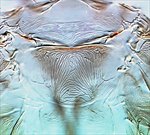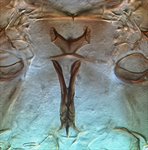Generic diagnosis
Head wider than long, constricted just behind compound eyes, sculptured with anastomosing striae; ocellar setae pair I absent, pair III long and arising between posterior ocelli; two pairs of postocular setae; compound eyes without pigmented facets; mouth-cone short and rounded with 3-segmented maxillary palps. Antennae 8-segmented, segment I with pair of dorso-apical setae; III and IV with sense-cones forked. Pronotum wider than long, with transverse anastomosing striae; two pairs of posteroangular setae and two pairs of posteromarginal setae. Metascutum median setae slightly behind anterior margin; campaniform sensilla absent. Mesosternal furca with spinula; metasternal furca with spinlula and strongly developed Y-shaped arms extending to mesothorax. Fore wing first vein with long gap in setal row, two setae distally; posterior fringe cilia wavy; clavus with four veinal and 0 or 1 discal setae. Tarsi 2-segmented. Tergites without ctenidia; tergites and sternites without craspeda; I-VIII laterally with parallel lines of sculpture curving to posterior; VIII without marginal comb, but with a few vestigial microtrichia medially and laterally; IX without campaniform
sensilla; X without median split. Sternites without discal setae.
Male tergite IX with a pair of horn-like drepanae on posterior margin; sternites III-VIII with scattered small pore plates.
Biological data
There are no reliable host records, but T. striatus has twice been taken from the leaves of Phyllanthaceae species (Li et al., 2019).
Distribution data
One of the species in this genus was described from Vietnam and the other from Thailand, but both are recorded from China.
Nomenclatural data
Trachynotothrips Masumoto & Okajima, 2005: 55. Type species Vulgatothrips striatus Masumoto & Okajima, 2005, by original designation.
Two species are placed in this genus (ThripsWiki, 2020), and both are recorded from China (Li et al., 2019))
brevispinis Masumoto & Okajima, 2005: 57.
striatus Masumoto & Okajima, 2005: 59.
Relationship data
Despite the elongate and bifurcate metathoracic furca that is similar to the structure found in Dendrothripinae, this genus is related to Trichromothrips in the presence of paired dorso-apical setae on antennal segment I, and in the presence in males of scattered small sternal pore plates and a pair of long drepanae on tergite IX.
References
Li YJ, Li ZY & Zhang HR (2019) Trichromothrips genus-group (Thysanoptera, Thripidae) from China, with descriptions of three new species and ten new records. Zootaxa 4544 (1): 079–092.
ThripsWiki (2020). ThripsWiki - providing information on the World's thrips. <http://thrips.info/wiki/Main_Page>


